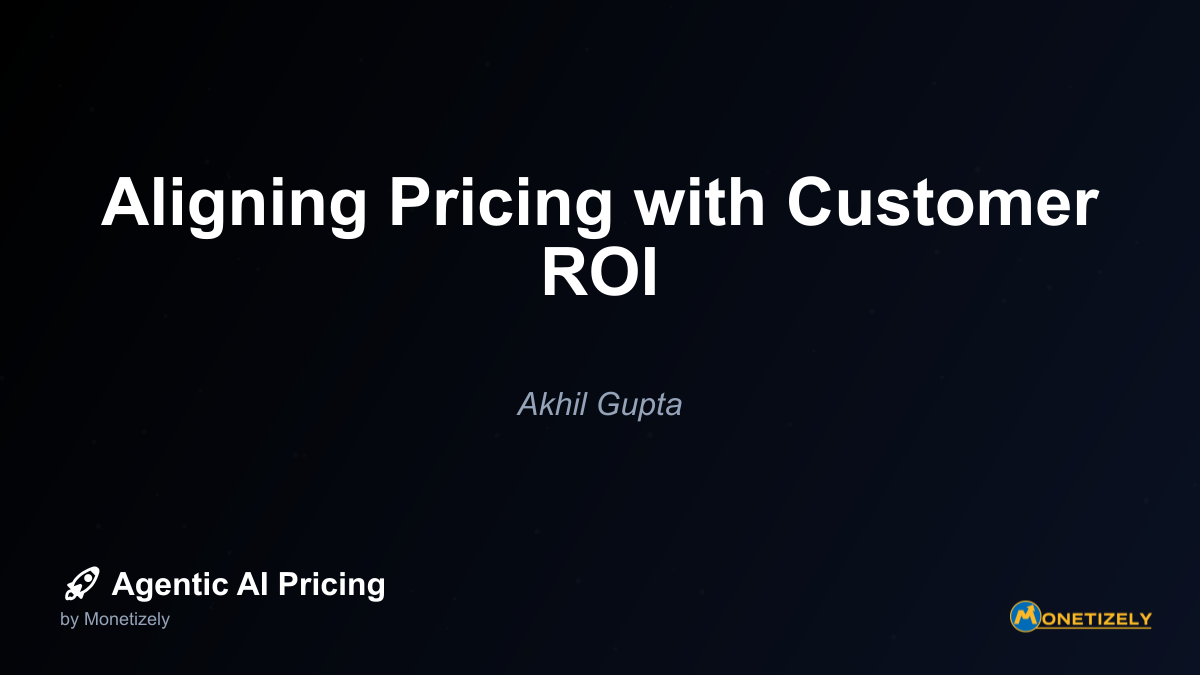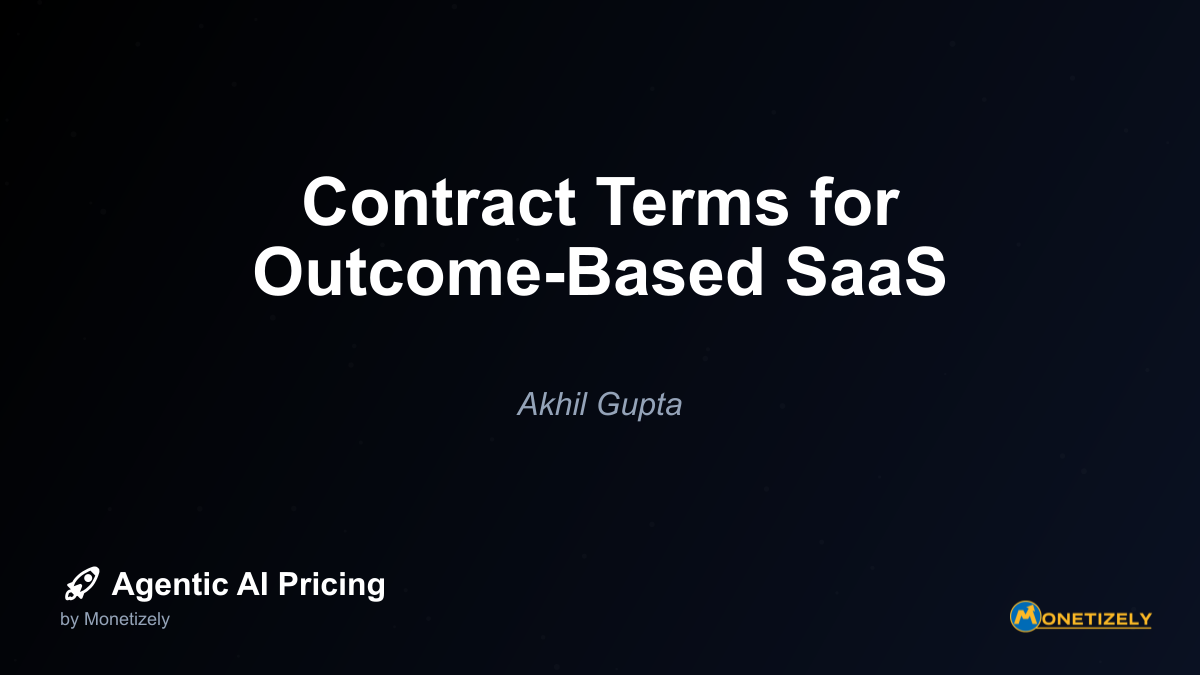· Akhil Gupta · Pricing Agentic SaaS Products · 5 min read
Per-Agent Pricing Models
AI and SaaS Pricing Masterclass
Learn the art of strategic pricing directly from industry experts. Our comprehensive course provides frameworks and methodologies for optimizing your pricing strategy in the evolving AI landscape. Earn a professional certification that can be imported directly to your LinkedIn profile.

Many workflows require multiple agents working in concert to deliver complete solutions. Rather than pricing each agent individually, consider offering bundles of complementary agents that work together to solve specific business problems.
For example, a sales acceleration suite might include:
- Lead qualification agent
- Meeting scheduling agent
- Follow-up communication agent
- Deal progress tracking agent
Bundling creates higher perceived value while simplifying the customer’s purchasing decision. It also allows for strategic pricing that encourages adoption of the complete solution rather than cherry-picking individual components.
This approach works particularly well for:
- End-to-end workflow automation
- Industry-specific solutions
- Complex processes requiring multiple specialized agents
- Cross-functional business challenges
When to Avoid Per-Agent Pricing
While per-agent pricing offers many advantages, it’s not universally applicable. Several scenarios call for alternative approaches:
When Agent Value Is Difficult to Isolate
If customers struggle to attribute specific outcomes to individual agents, per-agent pricing becomes challenging to justify. This occurs when:
- Multiple agents collaborate on outcomes
- Value emerges from the system rather than individual components
- Benefits are diffuse or difficult to measure
- The platform itself provides significant value beyond agent functionality
In these cases, alternative models like platform access fees or outcome-based pricing may better reflect the value delivered.
When Agent Deployment Is Technical
Per-agent pricing creates friction when deploying additional agents requires significant technical expertise or configuration. If customers need developer resources or extensive training to implement new agents, they’ll be reluctant to add agents even when the business case justifies expansion.
This challenge often appears in:
- Complex integration scenarios
- Highly technical platforms
- Solutions requiring extensive customization
- Environments with strict governance requirements
When Value Scales with Users, Not Agents
Sometimes, the primary value driver remains human usage rather than agent activity. If ten users working with one agent derive more value than one user with ten agents, per-user pricing better aligns with the customer’s value perception.
This pattern emerges when:
- Agents primarily enhance human productivity
- Value comes from human decisions informed by agent insights
- Collaboration between humans remains central to the workflow
- The software has significant non-agent functionality
Transitioning from Per-User to Per-Agent Pricing
For companies with established per-user pricing models, transitioning to per-agent pricing requires careful planning to avoid disrupting existing customer relationships. Consider these strategies:
Gradual Introduction Through New Products
Rather than overhauling existing pricing, introduce per-agent models through new product lines or advanced feature tiers. This allows customers to self-select into the new model while maintaining stability for your existing customer base.
For example, launch “AI-Enhanced” versions of your products with per-agent pricing while maintaining traditional per-user pricing for standard offerings. As customers experience the benefits of agent-based automation, they’ll naturally migrate toward the new model.
Hybrid Transitional Models
Create transitional pricing structures that incorporate elements of both models to ease the shift. For instance:
- Base platform fee (per organization) + per-user fee (for human access) + per-agent fee (for automation)
- User packs combined with agent allowances
- Credits that can be applied to either users or agents flexibly
These approaches allow customers to gradually shift their spending from users to agents as they increase automation, creating a smoother transition path.
Educational Marketing
The shift to per-agent pricing requires customers to think differently about value. Invest in educational content that helps them:
- Calculate ROI from agent deployment
- Measure productivity improvements
- Identify automation opportunities
- Compare agent costs to alternative approaches
This education helps customers recognize the value of agents as digital workers rather than mere software features, supporting the pricing transition.
Measuring Success in Per-Agent Pricing
Implementing per-agent pricing requires new metrics to evaluate success beyond traditional SaaS KPIs. Consider tracking:
Agent Adoption Rate
Monitor how quickly customers deploy agents after initial purchase. Low adoption rates may indicate:
- Onboarding challenges
- Unclear value proposition
- Implementation barriers
- Pricing that discourages expansion
Successful per-agent pricing should encourage customers to continuously add agents as they recognize the value delivered.
Agent-to-User Ratio
Track the number of agents deployed relative to human users across your customer base. This ratio helps identify:
- Automation maturity by customer segment
- Expansion opportunities in under-automated accounts
- Pricing optimization targets
- Trends in automation adoption
Rising agent-to-user ratios generally indicate successful value delivery and appropriate pricing alignment.
Agent Utilization Metrics
Measure how actively each deployed agent is used. Low utilization may signal:
- Pricing that’s too high for the value delivered
- Implementation challenges
- Feature gaps or performance issues
- Misalignment between agent capabilities and customer needs
High utilization validates your value proposition and pricing strategy.
Agent-Attributed Outcomes
Track business outcomes directly attributable to agent activity, such as:
- Tasks completed
- Time saved
- Revenue generated
- Costs avoided
- Quality improvements
These metrics help quantify the ROI customers receive from their agent investments, supporting retention and expansion.
Conclusion
Per-agent pricing represents a fundamental shift in how we think about software value. Rather than charging for access, this model recognizes AI agents as digital workers that actively create value through their continuous operation. When implemented thoughtfully, it creates stronger alignment between pricing and customer outcomes while opening new growth opportunities.
The decision between per-user and per-agent pricing isn’t binary—many successful companies employ hybrid approaches or offer multiple options to address different customer segments. The key is understanding how your specific AI agents create value and structuring your pricing to reflect that reality.
As AI capabilities continue to advance, we’ll likely see even more sophisticated pricing models emerge that combine elements of per-agent pricing with consumption metrics, outcome-based components, and value-sharing arrangements. The most successful companies will be those that continuously experiment with their pricing approach while maintaining a relentless focus on delivering measurable customer value through their agentic AI solutions.
For organizations navigating this transition, start with a clear assessment of how your agents create value, then design pricing that makes that value explicit to customers. With the right approach, per-agent pricing can create stronger alignment between your revenue model and your customers’ success—the ultimate goal of any sustainable pricing strategy.
Co-Founder & COO
Akhil is an Engineering leader with over 16+ years of experience in building, managing and scaling web-scale, high throughput enterprise applications and teams. He has worked with and led technology teams at FabAlley, BuildSupply and Healthians. He is a graduate from Delhi College of Engineering and UC Berkeley certified CTO.
Pricing Strategy Audit
Let our experts analyze your current pricing strategy and identify opportunities for improvement. Our data-driven assessment will help you unlock untapped revenue potential and optimize your AI pricing approach.




